How Clarence Darrow Came Again to Dayton
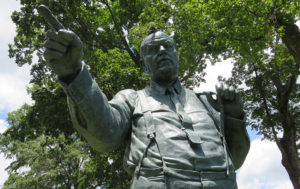 The new statue of Clarence Darrow is a commanding presence on the front lawn of the Rhea County Courthouse in Dayton, Tennessee.
The new statue of Clarence Darrow is a commanding presence on the front lawn of the Rhea County Courthouse in Dayton, Tennessee. Christian conservatives, despite their threats of protest, vandalism, and even violence, turned out to be a no-show. The hour-long ceremony the morning of July 14, 2017, unveiling a bronze statue of Clarence Darrow to stand opposite that of William Jennings Bryan on the front lawn of the Rhea County Courthouse in Dayton, Tennessee, went off pleasantly in front of a supportive audience.
This is the courthouse that served from July 10 to 21, 1925, as the stage for the high-profile legal drama known as the “Scopes monkey trial.” The defendant was Dayton high school teacher John T. Scopes, charged with violating state law by teaching that human beings evolved from a “lower order of animals.” Bryan was attorney for the prosecution and Darrow for the defense. It was a showdown between two oratorical giants that raised public debate on academic freedom, church-state separation, and the relationship between science and religion. Regarding the legal outcome, Scopes was convicted and fined $100, but in 1927 the decision was reversed on a technicality by the Tennessee Supreme Court.
Nonetheless, what had happened in the Rhea County Courthouse remained in the public consciousness. The place became a travel destination. A museum displaying artifacts from the trial was placed in its basement. In 1972 the courthouse was listed on the National Register of Historic Places. In 1976 the National Park Service named it a National Historic Landmark. And in 1979 the second-floor courtroom, which continues in use, was restored to how it appeared during the Scopes trial. Then in 2005, the eightieth anniversary of the trial, Bryan was memorialized with a statue on the courthouse lawn.
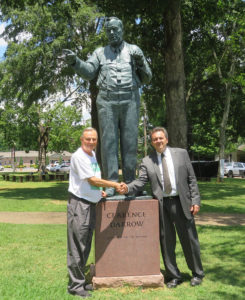
Fred Edwords with Zenos Frudakis in front of his now-famous sculpture of Clarence Darrow.
An account published in the July/August issue of the Humanist magazine (linked here) tells how a 2009 visit to the courthouse by humanist William Dusenberry ultimately led to the dedication last week of Zenos Frudakis’s Clarence Darrow sculpture.
What that article didn’t go into detail on, however, was the opposition to showing a more complete and balanced perspective on the Scopes trial. That opposition was led by a seventy-eight-year-old Dayton firebrand named June Griffin. She is a pastor of the American Bible Protestant Church who, according to the April 17 Times Free Press of Chattanooga, Tennessee, believes that Darrow and his supporters were seen by the public back in 1925 as mere curiosities. “People from all over the world came to see these idiots that didn’t believe that God created the world and man. . . . They traveled to see such a strange creature that would not believe the Bible.”
Moreover, Griffin proposed that the controversy over the statue be settled by each side forming its own militia. “I will challenge them to meet us in their uniforms at King’s Mountain . . . and we’ll settle it over there.”
On July 1, Griffin, along with the Reverend Dale Walker (president of the Tennessee Pastor’s Network) led an anti-Darrow-statue rally at the courthouse. About twenty protesters showed up and an equal number of pro-Darrow folks countered. There were no incidents.
At the actual unveiling ceremony on July 14, there was only one prominent religious presence. Someone had strategically placed a large banner on an outside courthouse wall that said: “Read your Bible.” I realized it would appear as a backdrop in all media images of the ceremony and mentioned this to Annie Laurie Gaylor, co-president of the Freedom From Religion Foundation, who was running the program. She thereupon spoke with the right people and the banner was obscured for the length of the celebration.
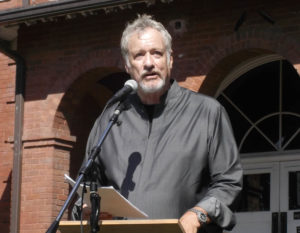
John de Lancie delivered a moving performance of Clarence Darrow’s most famous words at the Scopes trial.
Some star power was brought to the unveiling with the participation of actor John de Lancie, best known as Q in Star Trek (The Next Generation, Deep Space Nine, and Voyager series). Having also played Clarence Darrow on stage, de Lancie gave a moving presentation. A surprising development was the presence in the audience of Cessna Decosimo, sculptor of the Bryan statue, who emcee Margaret Downey introduced to the audience. She also introduced Dusenberry and me as two people who had worked in the beginning to get the project started. And, of course, FFRF co-presidents Dan Barker and Gaylor spoke on behalf of their organization, which had put up the $150,000 that made completion of the statue possible.
The only glitch was the minutes-long difficulty in finally removing the well-secured veil over the statue, a process that required the assistance of nearly everyone who had been part of the proceedings. But the standing-room-only crowd in attendance, vigorously using their “Fan of Reason” fans to beat the heat, expressed their support and enjoyment throughout. And many gathered for photos afterwards, posing with the statue and program participants.
So Clarence Darrow has returned to Dayton. He stands on the front courthouse lawn making a point to the Bryan statue on the other side. Inside the courthouse the story of their historic exchange is told in more detail. That all makes for another item to add to the bucket list of humanist tourists everywhere.
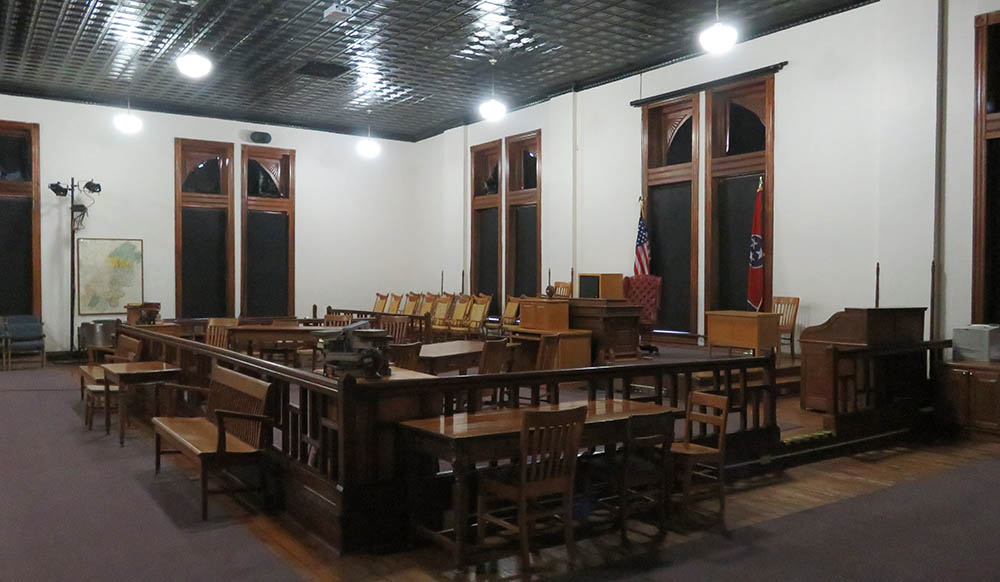
The courtroom, which is still in use, has been restored to how it looked during the Scopes trial.
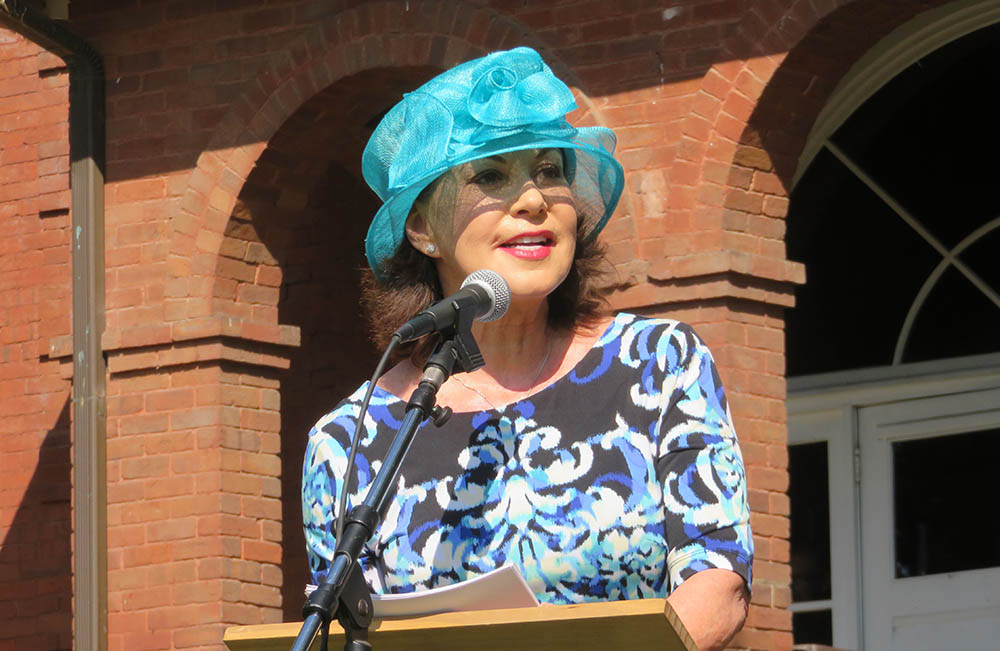
Margaret Downey, a current FFRF board member and past member of the AHA board, emceed the Darrow statue dedication.
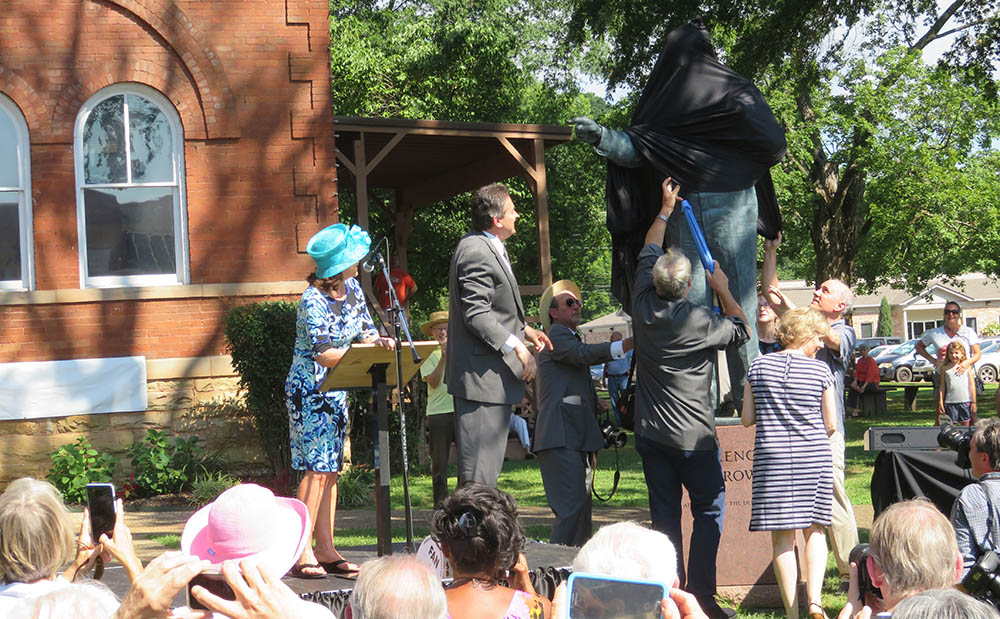
It was with some difficulty that the statue was finally unveiled.
All photos by Fred Edwords and Mary Murchison-Edwords
